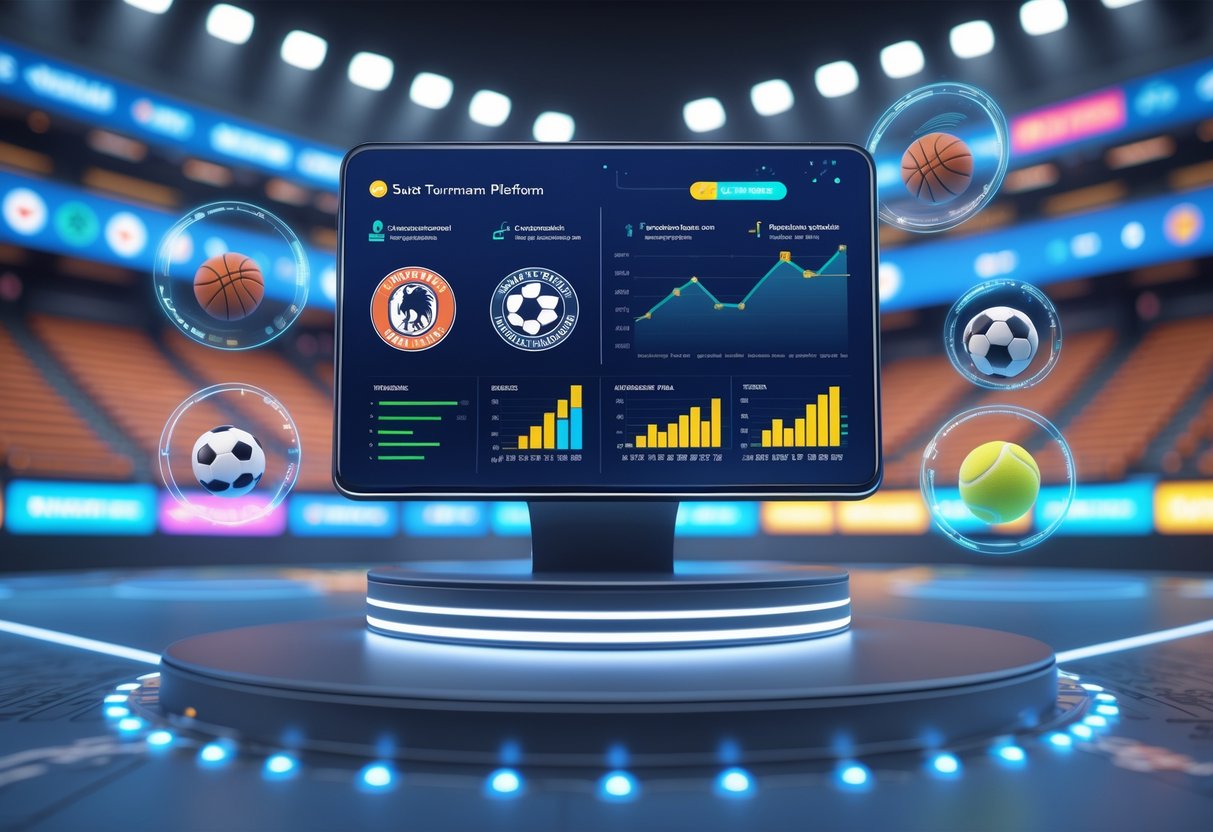Tournament Platforms Comparison: The Best Solutions Reviewed
Updated On: August 23, 2025 by Aaron Connolly
Top Tournament Platforms at a Glance

When you look at the tournament hosting landscape, a few platforms really stand out. ESL Play and FACEIT have proven themselves over the years, but newcomers like Battlefy and Toornament are shaking things up with fresh features.
Market-Leading Solutions
ESL Play has set the bar for serious tournament organisers. They’ve hosted major CS, Dota 2, and League of Legends events using reliable servers and admin tools that just work.
You get strong anti-cheat systems and deep match stats. Entry fees range from free community events up to paid tournaments with prize pools over £10,000.
FACEIT really owns the CS tournament space. Their matchmaking system automatically pairs players with similar skill levels, which is honestly a relief if you hate lopsided matches.
Their ladder system tracks your progress, so you always know where you stand. Premium features cost £3-8 a month, but free accounts still get you into most tournaments—just with lower server priority.
Challonge makes bracket creation almost too easy. You can set up a tournament in under five minutes thanks to their drag-and-drop interface.
Emerging Platforms to Consider
Battlefy draws in indie game tournaments and smaller communities. Their mobile app lets you check brackets and match times without any hassle.
Lately, we’ve seen them expand support for console tournaments, especially fighting games and sports titles. Registration fees usually sit between free and £15 per player.
Toornament stands out for its customisation options and flexible formats. Their API integration makes it simple for larger organisations to embed tournaments right into their own sites.
Bracketwise caters to local gaming cafes and small venues. Their offline tools actually work even if the internet drops out, which is a lifesaver sometimes.
Most new platforms charge about 5-10% commission on prize pools, which is a lot less than the 15-20% you’ll see from the big names.
Key Trends for 2025
Mobile-first design is now a must. Around 60% of participants sign up on their phones, so platforms without good mobile interfaces are falling behind fast.
Automated scheduling seriously cuts down on admin headaches. We’re pretty sure every major platform will have this within a year.
Integrated streaming tools are making separate broadcast setups kind of obsolete. Now, you can stream right to Twitch or YouTube with one click from your tournament dashboard.
Blockchain prize distribution is catching on for bigger events. Early adopters say payouts are about 50% faster than using banks.
AI-powered anti-cheat tools keep getting smarter. Some platforms now spot suspicious gameplay in real time, not just after the match ends.
Core Features for Effective Tournament Management

Modern tournament platforms really need three things: automated scheduling tools, live score tracking, and secure payment systems that cover everything from sign-up to prize payouts.
Scheduling and Bracket Creation
Scheduling tools can make or break your tournament. The best platforms build brackets automatically based on how many people sign up and which format you pick.
Single elimination, double elimination, and round-robin formats should all work smoothly. We’ve watched organisers waste hours fiddling with brackets when software could do it in minutes.
Key scheduling features:
- Automatic bracket generation for all main formats
- Support for different time zones
- Tracking for venues and equipment
- Real-time updates when matches run late
Smart platforms also deal with bye rounds and seeding for you. This means less boring admin work and fairer matchups.
A lot of platforms now offer visual brackets you can check on your phone. That kind of transparency keeps confusion and support questions to a minimum.
Real-Time Scoring and Updates
Live scoring keeps everyone in the loop. Players, spectators, and organisers all need instant updates on results and standings.
The best systems let you enter scores from your phone. Match officials can update results on the spot, no need to run back to a PC.
Must-have scoring features:
- Mobile-friendly score entry
- Automatic bracket advancement
- Live leaderboards
- Push notifications for key updates
Automated systems cut down on scoring mistakes. They also help avoid arguments about who advances in the bracket.
Some platforms even tie in with streaming services to show live scores during broadcasts. That’s a big deal for esports fans watching multiple matches at once.
Registration and Payment Systems
A solid registration system makes sign-ups and payments painless. Modern platforms accept cards, PayPal, and bank transfers, so nobody gets left out.
Flexible pricing is important for early bird deals and team discounts. The best systems handle that automatically depending on when people register.
Core registration features:
- Secure payment with SSL
- Automated confirmation emails and receipts
- Refund management for dropouts
- Participant data collection and storage
Integrating with trusted payment providers builds confidence. Clear refund policies on the registration page save headaches later.
Many platforms now manage waitlists for full tournaments. This helps organisers fill every spot without breaking venue limits.
Comparing Usability and User Experience

The best tournament platforms strike a balance between powerful features and easy navigation. Organisers and participants just want to focus on the competition, not wrestle with clunky menus.
Admin and Organiser Interfaces
Organisers need dashboards that make complex tasks simple. The good platforms put bracket management, scoring, and communication tools right where you need them.
Key admin features:
- One-click bracket creation for any format
- Real-time score updates with easy conflict resolution
- Bulk messaging for updates
- Simple registration and payment tracking
Platforms like Brakto and TournamentSR really help by automating bracket progression and handling tie-breakers for you.
Quick setup is everything. Nobody wants to spend hours building a 64-player tournament. Look for templates and presets that speed things up.
It’s frustrating when platforms scatter key functions across a bunch of pages. The best solutions keep the important stuff on the main dashboard.
Participant and Team Access
Players want fast access to brackets, schedules, and opponent info—no digging through endless menus. Registration should be quick, whether you’re solo or with a team.
Important participant features:
- Bracket visualisation that works on any device
- Match notifications with time and place
- Easy score reporting and dispute options
- Team roster management for group sign-ups
Challonge nails simplicity with clean bracket displays and just a few clicks to find your match.
Registration pain points turn people away. If a platform asks for endless verification or tricky payments, players will bail before the event even starts.
The best systems send automatic match reminders. Players get pings 30 minutes before their games, which really cuts down on no-shows.
Mobile App Support
Players check brackets all day during tournaments, so mobile support isn’t optional anymore. Native apps usually beat mobile websites, especially for heavy use.
Mobile must-haves:
- Fast bracket loading even on bad Wi-Fi
- Push notifications for match alerts
- Offline bracket viewing for spotty connections
- Simple score reporting, maybe with photo uploads
Dedicated apps just feel smoother than mobile sites. They cache bracket data and keep working when the venue’s Wi-Fi goes down.
Battery life actually matters. Apps that constantly refresh will drain your phone before finals. The best ones update only when needed.
Venues often have unreliable internet. Platforms with offline support let players see brackets and submit scores as soon as they’re back online.
Customisation and Flexibility Options

Platforms differ a lot in how well they adapt to different event types and branding needs. The top choices support lots of formats and let organisations run fully branded events.
Tournament Formats Supported
Most platforms cover single and double elimination brackets. The more advanced ones really open up your options.
Round-robin tournaments suit small groups where everyone plays everyone. It’s fair, but it takes longer.
Swiss-style brackets are a nice compromise. Teams with similar records face off each round, so matches stay competitive without dragging on forever.
Top platforms also allow hybrid formats—maybe group stages followed by knockouts. Lots of big esports events use this setup.
Custom scoring systems are a must for certain games or sports. Some platforms let you tweak point values, tie-breakers, and advancement rules. That flexibility is essential for unique formats.
Event Branding and White Labelling
White-labelling removes the platform’s logos from your tournament pages, so your brand stands front and centre.
You can upload your own colours and logos to keep things consistent. The best platforms let you customise the whole visual theme.
Domain customisation lets you host tournaments on your own URL, not the platform’s. That builds trust with both players and sponsors.
Some platforms even let you brand the mobile app. Players can download an app just for your tournament series, which is great for recurring events.
Sponsor integration is a big deal for revenue. Good platforms let you show off partner logos and links wherever you want.
Best Choices for Sports Organisations

Sports organisations have different needs depending on their structure and audience. The big question is whether to use all-in-one platforms or specialised tools, and which systems really work for youth and amateur sports.
Standalone vs Integrated Solutions
Sports organisations often have to pick between standalone tournament software and all-in-one management platforms. Standalone tools like My Cup just focus on tournaments and brackets. They’re simple to set up and don’t cost much.
Integrated platforms do more—they handle tournaments, registration, communication, and even league management. SportsPlus is a good example, offering everything from player profiles to scheduling.
Standalone perks:
- Lower monthly fees
- Fast tournament setup
- Simple to learn
- No extra fluff
Integrated platform perks:
- One login for everything
- Shared player databases
- Unified messaging
- Better tracking across seasons
Most youth clubs lean toward integrated platforms. Adult rec leagues usually stick with standalone tools for specific tournaments.
Youth and Amateur Sports Focus
Youth sports organisations have different priorities than pro tournaments. Registration management is huge, especially for handling parent messages and medical forms. Some platforms now specialise just for this market.
Key youth features include parent notifications, age-based roster limits, and easy bracket formats. TeamSnap and similar tools blend tournaments with team chat and updates.
Amateur clubs need affordable tools that volunteers can run easily. Overly complex features just confuse the parents who end up organising everything.
Must-have youth features:
- Parent communication tools
- Age verification
- Medical form collection
- Volunteer scheduling
Most youth groups start with free tiers for small tournaments. That way, they can try things out before paying for bigger events.
eSports-Specific Platform Comparison

Esports platforms really shine with dedicated matchmaking and built-in streaming. These features make them way better for gaming events than general-purpose tournament software.
Online Matchmaking and Leaderboards
Esports platforms use automated matchmaking to pair players by skill and in-game stats. FACEIT leads the way, especially for CS and Valorant, with tough anti-cheat and skill-based rankings. Their system balances teams and tracks performance stats across thousands of matches every day.
GameBattles runs ladder systems where you climb by winning. Ladders reset every season, so new players can always get a shot at the top. The platform tracks win-loss records, K/D ratios, and all the stats that matter to competitive gamers.
Heads up: Some platforms hype up their player numbers. It’s smarter to check how many people are online right now, not just total sign-ups.
Toornament gives you leaderboards for over 200 games, though their matchmaking is more about tournament brackets than ongoing ladders. UMGgaming mixes both styles, offering head-to-head matches and structured tournaments.
Pro tip: Try free ladder matches on sites like GameBattles to see where you stand before jumping into paid tournaments.
Streaming and Broadcast Integrations
Top esports platforms now connect straight to Twitch and YouTube, making it easier for players to create content while competing. On Gamersaloon, you just link your Twitch channel, and the system promotes your stream automatically when your match starts.
This setup lets competitive players grow their audience as they chase prize money.
FACEIT gives you built-in streaming tools and match replays you can export for content. Their Twitch partnership even generates highlights from competitive matches without much effort.
ESL Play does something similar for bigger tournaments, adding pro-level overlays and live stats to their broadcasts.
Some platforms do charge extra for streaming features. Battlefy includes basic broadcast tools for free, but platforms like GameBattles put advanced streaming behind a paywall.
Mobile-first platforms usually don’t offer the same streaming support as their PC rivals. If you care about content creation, think carefully before picking a tournament platform—switching later can really mess with your audience-building.
Pricing Models and Value for Money

Tournament platforms use all sorts of pricing structures to fit different budgets and event sizes. Organisers need to understand these models to avoid paying for features they’ll never use.
Free vs Paid Platforms
Free platforms like Challonge let you create basic brackets and manage small events without spending a penny. They’re perfect for first-timers or local groups just testing things out.
Challonge gives you unlimited single-elimination tournaments but charges for double-elimination. My Cup offers a free tier with the basics for beginners.
Free platforms usually cap participant numbers, strip out branding, or stick ads on your pages. If you have more than 50 players, these limits can get annoying fast.
Paid platforms unlock extras like custom domains, analytics, and sponsor tools. They also tend to have better support and more stable servers when things get busy.
Quick pricing notes:
- Free: £0-10/month for basics
- Paid: £15-100+ monthly for pro features
- Enterprise: Custom pricing for really big events
Subscription and One-Time Costs
Most platforms run on monthly or yearly subscriptions instead of one-off purchases. Subscriptions cover updates, server costs, and support.
Brakto starts at about £20/month for small tournaments. TournamentSR has tiered pricing based on how many people you expect and what features you need.
Yearly subscriptions usually save you 20-30% over monthly payments. If you run tournaments regularly, going annual just makes sense.
Some platforms charge per-tournament fees instead. That’s fine if you only host events occasionally, but it adds up quickly if you’re running things all the time.
Watch for hidden costs like:
- Payment processing (2-5% of entry fees)
- Premium support
- Extra user licenses
- Custom development
Cloud-based options have made it way more affordable for small groups to run tournaments, without losing out on scalability.
Support, Training, and Community Resources

Most tournament platforms come with help centers packed with step-by-step guides and video walkthroughs. You’ll also find community forums where organisers swap tips and troubleshoot together.
Help Centres and Documentation
The best platforms write documentation that covers everything—from basic setup to power-user tricks. Challonge and Bracketwise, for example, have searchable knowledge bases sorted by topic.
Video tutorials are a lifesaver if you learn visually. Most platforms post screen recordings that show you how to create brackets, manage signups, and run live events.
Pro tip: Choose platforms with mobile-friendly help docs. You’ll probably need them on-site at some point.
Some platforms let you download PDF guides for offline use. That’s handy if you end up somewhere with spotty internet.
The strongest platforms keep their docs up to date. They add new articles when features change and clear out old info that might trip you up.
User Forums and Peer Support
Active forums let organisers learn from people who’ve already faced the same headaches. Good communities have sections for different event types—esports, sports leagues, or just-for-fun competitions.
Heads up: Not every forum post is accurate, especially from newbies. Stick to advice from verified mods or experienced users.
Reddit and Discord often fill in the gaps. Organisers share templates, troubleshooting hacks, and event management stories in these unofficial spaces.
Some platforms pick community champions who answer questions and help out. These volunteers often reply faster than official support—especially during evenings and weekends.
The best forums offer real-world examples, not just theory. Look for places where people post screenshots, templates, and step-by-step breakdowns.
Security and Data Privacy Considerations

Tournament platforms handle sensitive stuff—player info, payments, match data. They need to protect all of it, especially with regulations like GDPR in play.
Compliance Standards and Certifications
SOC 2 Type II certification is the gold standard here. Auditors check platforms for secure access, monitoring, and encryption. Battlefy and Challonge, for example, show off these certificates.
ISO 27001 compliance means platforms follow global security standards. Look for regular security audits and penetration tests. Some platforms even publish yearly security reports.
You should check for:
- Two-factor authentication for admins
- SSL encryption everywhere
- Frequent security updates
- Backup and disaster recovery plans
If a platform can’t show clear security docs, steer clear.
GDPR and Personal Data Protection
Platforms working with European players must follow GDPR rules. That means getting consent for data collection and letting players control their info.
Data minimisation is key—platforms should only ask for what they need. Good ones let players download their data, ask for deletions, or tweak privacy settings.
You’ll want to see:
- Clear privacy policies
- Consent management for marketing
- Data breach notifications within 72 hours
- Right to be forgotten tools
Platforms must also protect data when working with sponsors or streaming partners. Article 28 GDPR requires contracts that spell out data protection responsibilities with third parties.
Many platforms now offer data residency choices, so you can pick where your players’ data lives.
Integration with Other Tools and Systems

Modern tournament platforms really shine when they connect with your other tools. Most offer website integration and API access. Others focus on Discord or CRM connections.
Website and API Integrations
Platforms give you different options for website integration. Some just hand you an embed code so you can drop brackets right onto your site.
Basic embedding usually works with an iframe. Copy, paste, and boom—your bracket updates as soon as the match ends.
More advanced platforms offer API access. Developers can pull in real-time match results, player stats, schedules, and registration info for custom setups.
WordPress plugins are a lifesaver for gaming sites. Challonge and Bracketwise have dedicated plugins, usually free.
Some platforms charge for API access—expect £10-50/month for premium features. Free tiers often limit how many requests you can make.
White-label options let you fully rebrand the experience. Your logo, your colors, your vibe—usually for £100+ monthly.
CRM and Communication Tools
Organisers need to talk to lots of players. The best platforms hook into tools you already use.
Discord integration is a must for gaming events. Some platforms auto-create channels and post match updates straight to your server.
Email marketing works through services like Mailchimp. You can add players to mailing lists automatically and keep them in the loop for future events.
Streaming integration connects with Twitch and YouTube. Some platforms update stream titles with match info or grab viewer counts on the fly.
Payment processing links with PayPal, Stripe, and others. Entry fees get collected at signup, and you can automate prize payouts.
Many platforms offer Slack integration for staff. Updates about issues or disputes go straight to your team’s channel.
Case Studies and Success Stories

Tournament platforms have powered everything from major sports events to grassroots communities. The USGA, for instance, transformed its tournament management with automated scoring, while ESTUDIOS built passionate gaming communities around brands.
Professional Sports Events
The USGA’s Tournament Players Platform (TPP) shows how sports organisations benefit from modern tournament systems. Their new platform automated scoring and improved data accuracy for tournaments of all sizes.
Before this, administrators wrestled with manual scoring and course ratings. The upgrade changed how they set up tournaments, handled live scoring, and distributed results.
What changed:
- Automated scoring cut down on human error
- Tournament setup got way easier
- Admins had a much better experience
- Data accuracy improved across the board
The Citi Open tennis tournament in D.C. highlights the value of connectivity solutions. Astound Business delivered integrated internet, voice, and video tailored for this high-profile event.
Sports organisations usually see instant benefits from dedicated platforms. These tools handle complex brackets, live streaming, and real-time results that old methods just can’t match.
Community and Grassroots Tournaments
ESTUDIOS, a Swiss esports agency, uses StriveCloud to build what they call a “sandbox environment” for brands and streamers. This helps them create real gaming communities instead of just running one-off tournaments.
Their secret? Treating tournaments as community-building tools. Brands get to interact with gamers in a way that feels genuine.
GameTurnier did something similar with whitelabel tournament tech. They started small but now land big brand partnerships and sponsorships.
Their approach:
- Build engaged gaming communities first
- Add features players actually want
- Give brands natural ways to connect with gamers
Youth football tournaments have also benefited from Tournament Organiser’s custom solutions. These grassroots events now get live results, auto-updating brackets, and easy communication for parents.
Community tournaments often start tiny but scale up fast when they solve real problems. The best platforms make organising simple for volunteers and keep things fun for players.
Frequently Asked Questions

Choosing a tournament platform usually comes down to the right features, prize handling, and game integration. Here are the most common questions we hear when people try to pick the best option for their needs.
What are the top features to consider when choosing an esports tournament platform?
Real-time bracket management really sits at the top for most organisers. Platforms like Challonge and Brakto update brackets automatically and let you track scores live.
Customisable tournament formats are a must. Most options support single elimination, double elimination, and round-robin setups. Some even handle group stages and playoffs without much hassle.
Don’t underestimate chat and communication tools. Players need fast ways to set up matches and report scores.
Prize distribution tracking saves everyone a lot of stress. The best platforms work with payment systems and keep prize pools transparent.
If you want to build a community, look for stats tracking. Platforms that show match histories and player stats usually keep people coming back.
How do different platforms handle prize distribution for esports tournaments?
Most big-name platforms use escrow to keep prize money safe. Toornament and others ask organisers to deposit funds before things kick off.
Premium platforms send out prizes automatically after the event ends. On the other hand, basic ones make you handle payouts yourself, often using outside payment apps.
Processing fees usually fall between 3% and 5% of the total prize pool. Some places skip fees for tournaments under £100 or for registered groups.
PayPal is still the go-to for payouts. Lately, newer sites are adding crypto and direct bank transfer options.
Enterprise-level platforms even include tax reporting features. These tools create all the documents organisers and winners need for taxes.
Can you recommend any platforms specifically tailored for amateur esports tournaments?
Challonge stands out for small amateur events, especially with its free plan. You can run up to 256 participants without paying a thing.
Ignite Tournaments gears itself toward amateur and semi-pro competitions. They throw in coaching and skill tracking, which is pretty neat.
Bracketwise gives great value for community tournaments. Their plans start at £15 a month for unlimited amateur events.
A lot of local gaming centres like TournamentSR for in-person events. It handles hybrid online-offline formats well.
Discord integration makes some platforms extra friendly for amateurs. Players can hop into voice chats straight from the brackets.
What are some of the largest esports events in terms of viewership and how do their chosen platforms enhance the experience?
The International relies on custom Valve systems built into Steam. This setup enables real-time item drops and lets viewers watch right in the game client.
League of Legends World Championship runs on Riot’s own tournament realm. That system handles millions of live viewers with barely any lag.
CS Majors use FACEIT’s infrastructure for player-facing tools. FACEIT manages qualifiers and brings in anti-cheat support.
Major events mix different platform technologies. Streaming gets its own dedicated setup, while player management works on separate systems.
Viewers get live stats, different camera angles, and interactive brackets. Custom platforms help sponsors blend in their promos without interrupting the action.
Which esports tournament platforms offer the best integration with popular games?
Steam integration works well with platforms like FACEIT and ESL Play. Players can launch matches right from Steam if servers are set up correctly.
Riot Games titles need special API access, which platforms like Tournament Realm deliver. Custom games start automatically with the right settings.
Blizzard games pair up nicely with Battle.net-friendly platforms. StarCraft II and Overwatch tournaments benefit from automated lobby creation.
Console integration isn’t great on most platforms. PlayStation and Xbox events usually need players to coordinate everything themselves.
Mobile game support is catching up fast. Platforms now handle games like PUBG Mobile and Mobile Legends with automatic match reporting.
Could you list the esports platforms that support large-scale tournament organisation?
ESL Play runs thousands of tournaments at once, spanning a bunch of different games. They handle both amateur and pro competitions pretty smoothly.
FACEIT focuses on big matchmaking systems, and they’ve built in anti-cheat features. Millions of players from around the world use their platform.
Toornament gives major organisers enterprise-level tools. Their system can handle events with hundreds of thousands of participants, which is honestly impressive.
Battlefy helps large esports organisations manage tournaments from start to finish. They’ve also added options for sponsorships and broadcasting, which makes things easier.
ESEA hosts dedicated servers along with their tournament tools. This setup especially shines for CS competitions when you need things to scale up.

